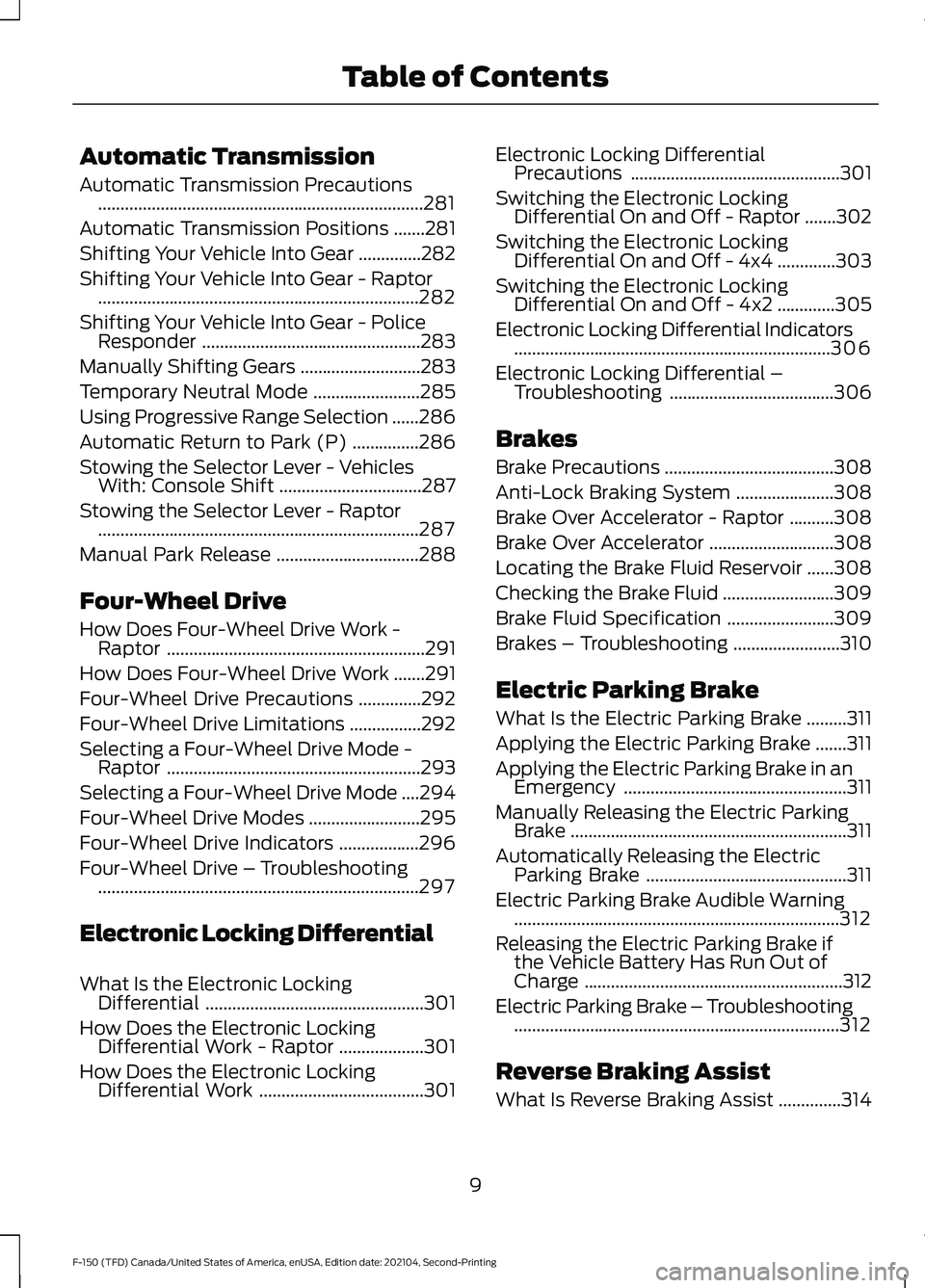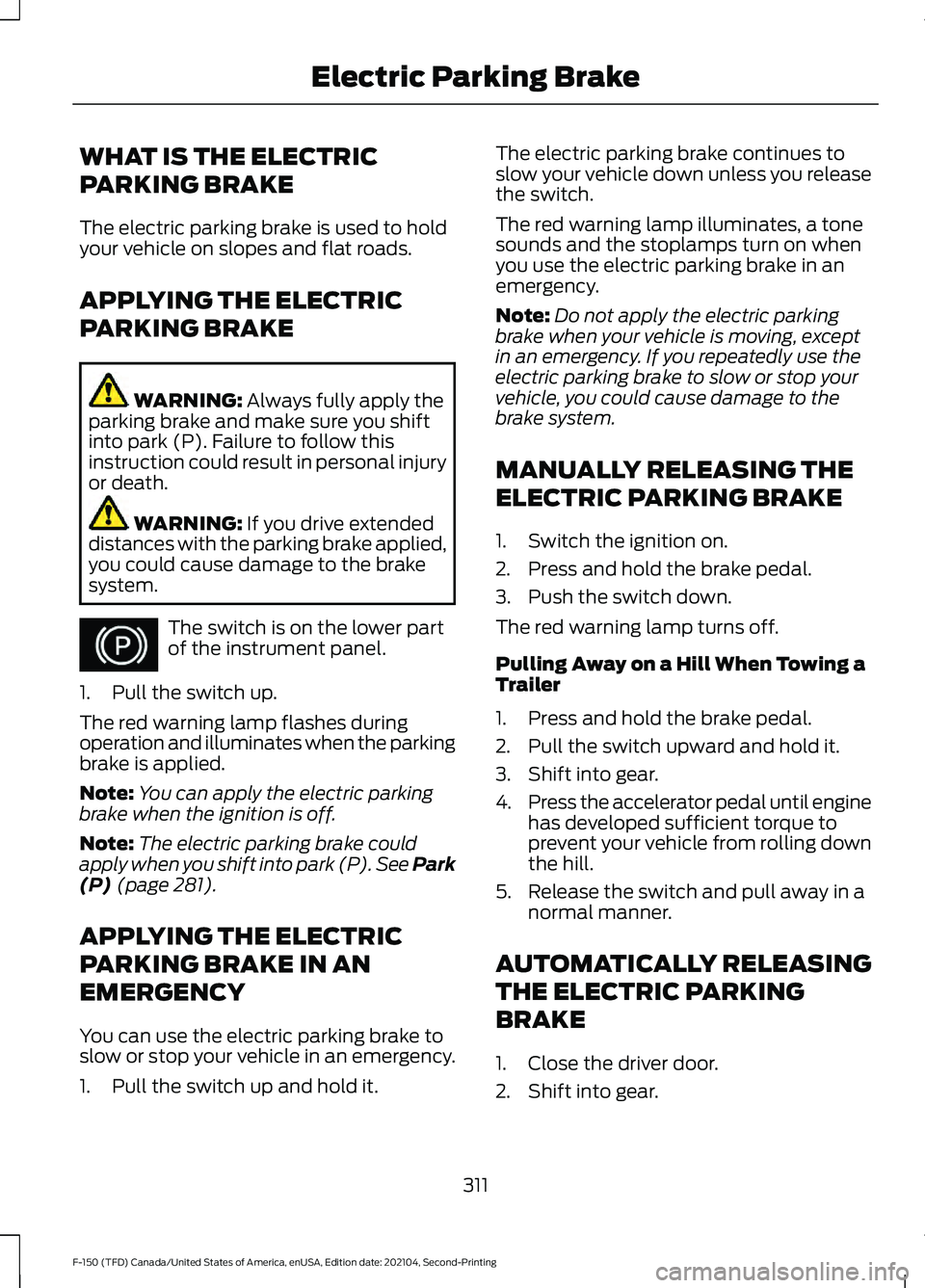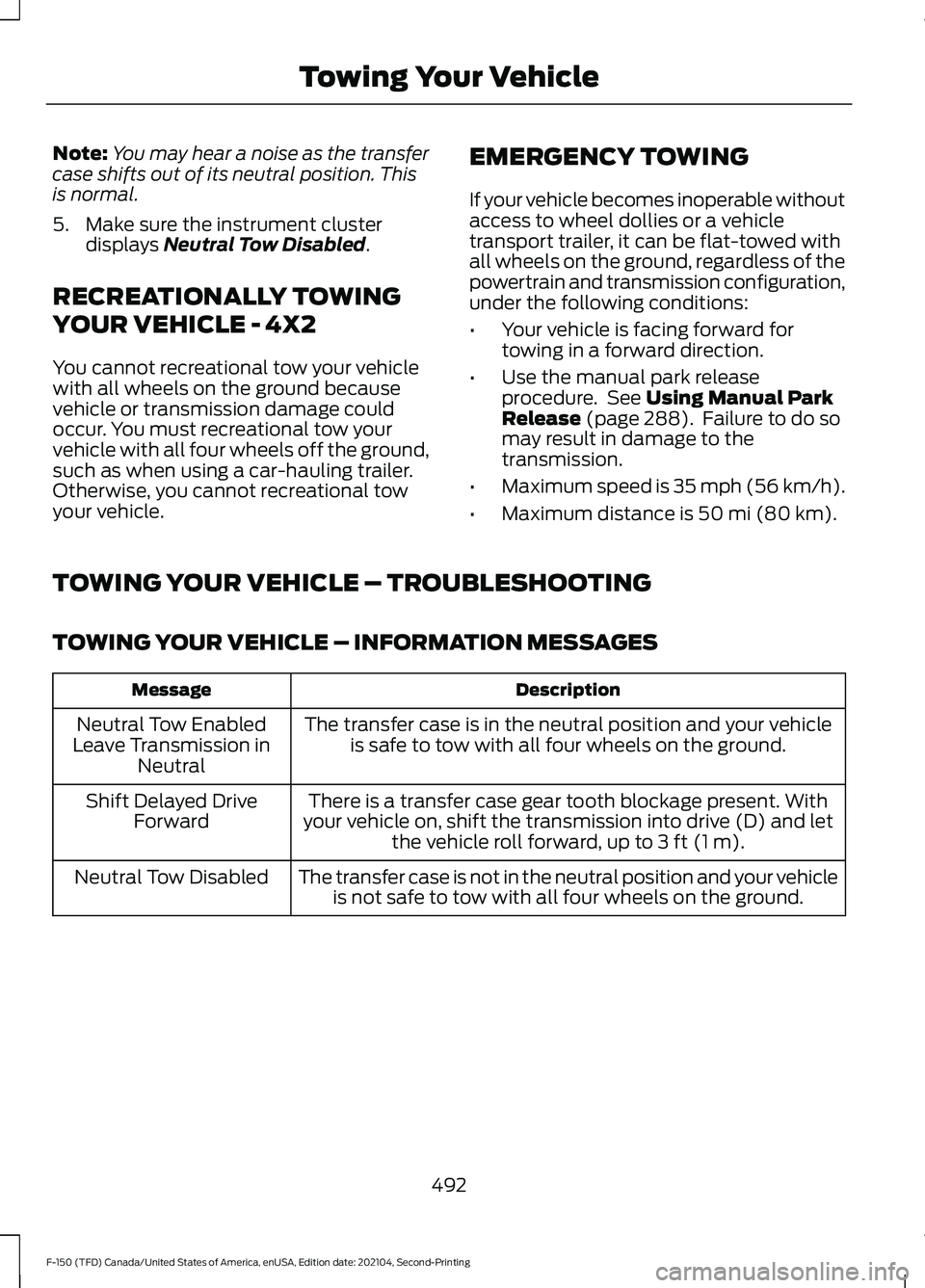2021 FORD F-150 emergency towing
[x] Cancel search: emergency towingPage 13 of 796

Automatic Transmission
Automatic Transmission Precautions
........................................................................\
.281
Automatic Transmission Positions .......
281
Shifting Your Vehicle Into Gear ..............
282
Shifting Your Vehicle Into Gear - Raptor ........................................................................\
282
Shifting Your Vehicle Into Gear - Police Responder .................................................
283
Manually Shifting Gears ...........................
283
Temporary Neutral Mode ........................
285
Using Progressive Range Selection ......
286
Automatic Return to Park (P) ...............
286
Stowing the Selector Lever - Vehicles With: Console Shift ................................
287
Stowing the Selector Lever - Raptor ........................................................................\
287
Manual Park Release ................................
288
Four-Wheel Drive
How Does Four-Wheel Drive Work - Raptor ..........................................................
291
How Does Four-Wheel Drive Work .......
291
Four-Wheel Drive Precautions ..............
292
Four-Wheel Drive Limitations ................
292
Selecting a Four-Wheel Drive Mode - Raptor .........................................................
293
Selecting a Four-Wheel Drive Mode ....
294
Four-Wheel Drive Modes .........................
295
Four-Wheel Drive Indicators ..................
296
Four-Wheel Drive – Troubleshooting ........................................................................\
297
Electronic Locking Differential
What Is the Electronic Locking Differential .................................................
301
How Does the Electronic Locking Differential Work - Raptor ...................
301
How Does the Electronic Locking Differential Work .....................................
301Electronic Locking Differential
Precautions ...............................................
301
Switching the Electronic Locking Differential On and Off - Raptor .......
302
Switching the Electronic Locking Differential On and Off - 4x4 .............
303
Switching the Electronic Locking Differential On and Off - 4x2 .............
305
Electronic Locking Differential Indicators .......................................................................
306
Electronic Locking Differential – Troubleshooting .....................................
306
Brakes
Brake Precautions ......................................
308
Anti-Lock Braking System ......................
308
Brake Over Accelerator - Raptor ..........
308
Brake Over Accelerator ............................
308
Locating the Brake Fluid Reservoir ......
308
Checking the Brake Fluid .........................
309
Brake Fluid Specification ........................
309
Brakes – Troubleshooting ........................
310
Electric Parking Brake
What Is the Electric Parking Brake .........
311
Applying the Electric Parking Brake .......
311
Applying the Electric Parking Brake in an Emergency ..................................................
311
Manually Releasing the Electric Parking Brake ..............................................................
311
Automatically Releasing the Electric Parking Brake .............................................
311
Electric Parking Brake Audible Warning ........................................................................\
.
312
Releasing the Electric Parking Brake if the Vehicle Battery Has Run Out of
Charge ..........................................................
312
Electric Parking Brake – Troubleshooting ........................................................................\
.
312
Reverse Braking Assist
What Is Reverse Braking Assist ..............
314
9
F-150 (TFD) Canada/United States of America, enUSA, Edition date: 202104, Second-Printing Table of Contents
Page 19 of 796

Crash and Breakdown
Information
Roadside Assistance .................................483
High Voltage Battery Vehicle Precautions - Hybrid Electric Vehicle (HEV) ........
484
Switching the Hazard Flashers On and Off ................................................................
485
Jump Starting the Vehicle .......................
485
Post-Crash Alert System .........................
487
Automatic Crash Shutoff ........................
487
Recovery Towing ........................................
488
Transporting the Vehicle .........................
489
Towing Your Vehicle
Towing Your Vehicle Precautions ........
490
Recreationally Towing Your Vehicle - 4x4 ..............................................................
490
Recreationally Towing Your Vehicle - 4x2 ........................................................................\
492
Emergency Towing ....................................
492
Towing Your Vehicle – Troubleshooting ........................................................................\
492
Fuses
Fuse Precautions ........................................
493
Under Hood Fuse Box ...............................
493
Body Control Module Fuse Box ............
499
Identifying Fuse Types ..............................
502
Fuses – Troubleshooting .........................
502
Maintenance
Maintenance Precautions .......................
503
Opening and Closing the Hood .............
503
Under Hood Overview - 2.7L EcoBoost™ .......................................................................
504
Under Hood Overview - 3.0L Diesel .....
505
Under Hood Overview - 3.3L .................
506
Under Hood Overview - 3.5L Ecoboost™ ........................................................................\
507
Under Hood Overview - 3.5L, Hybrid Electric Vehicle (HEV) .........................
508Under Hood Overview - 5.0L
.................
509
Engine Oil .......................................................
510
Checking the Coolant .................................
511
Engine Air Filter .............................................
515
Draining the Fuel Filter Water Trap - Diesel ...........................................................
518
Changing the Fuel Filter - Diesel ...........
519
Changing the Fuel Filter - Gasoline ......
519
Changing the 12V Battery .........................
519
Adjusting the Headlamps .........................
521
Exterior Bulbs ...............................................
522
Interior Bulbs .................................................
531
Drive Belt Routing - 2.7L EcoBoost™, Vehicles With: Dual Generators .........
531
Drive Belt Routing - 2.7L EcoBoost™, Vehicles With: Single Generator ........
531
Drive Belt Routing - 3.0L Diesel ..............
531
Drive Belt Routing - 3.3L ...........................
532
Drive Belt Routing - 3.5L Ecoboost™, Vehicles With: Dual Generators ........
532
Drive Belt Routing - 3.5L Ecoboost™, Vehicles With: Single Generator .......
532
Drive Belt Routing - 3.5L, Hybrid Electric Vehicle (HEV) ..........................................
532
Drive Belt Routing - 5.0L, Vehicles With: Single Generator .....................................
533
Drive Belt Routing - 5.0L, Vehicles With: Dual Generators ......................................
533
Vehicle Care
Cleaning Products ......................................
534
Cleaning the Exterior .................................
535
Cleaning the Interior ...................................
537
Repairing Minor Paint Damage .............
539
Waxing Your Vehicle ..................................
539
Storing Your Vehicle
Preparing Your Vehicle for Storage ......
540
Removing Your Vehicle From Storage ........................................................................\
.
541
15
F-150 (TFD) Canada/United States of America, enUSA, Edition date: 202104, Second-Printing Table of Contents
Page 292 of 796

Note:
Do not store objects in the selector
lever stow bin, and be sure that the bottom
selector lever tray mat is flat inside the
selector lever stow bin.
Note: If there are objects in the stow bin
while stowing the selector lever, the selector
lever could come back to the upright park
(P) position.
MANUAL PARK RELEASE
WHAT IS MANUAL PARK RELEASE
Manual park release allows you to move
your transmission out of the park (P)
position in the event of an electrical
malfunction or emergency.
MANUAL PARK RELEASE
PRECAUTIONS WARNING: When doing this
procedure, you need to take the
transmission out of park (P) which
means your vehicle can roll freely. To
avoid unwanted vehicle movement,
always fully apply the parking brake prior
to doing this procedure. Use wheels
chocks if appropriate. WARNING:
If the parking brake is
fully released, but the brake warning
lamp remains illuminated, the brakes
may not be working properly. Have your
vehicle checked as soon as possible. WARNING:
Do not drive your
vehicle until you verify that the
stoplamps are working.
Use the manual park release to move your
transmission from the park (P) position in
the event of an electrical malfunction or
emergency. See
Emergency Towing
(page 492).
Note: Do not engage the manual park
release with the engine on.
USING MANUAL PARK RELEASE
Activating the Manual Park
Release Cable
1. Apply the parking brake. See Electric
Parking Brake
(page 311).
Note: If vehicle battery is dead, for example,
no electrical power available, an external
power source may be required to apply the
parking brake.
2. Locate the manual park release cable access cover at the bottom of the
driver dash lower panel, under the
steering wheel.
288
F-150 (TFD) Canada/United States of America, enUSA, Edition date: 202104, Second-Printing Automatic TransmissionE347229
Page 293 of 796

3.
Carefully open the hinged access cover
using a plastic type wedge or pry tool
at the upper edge of the panel. If done
correctly, the panel will swing
downward.
Note: Do not activate the override lever
until you are in the driver's seat. If damage
occurs when access cover is opened,
contact your authorized Ford Dealer for a
replacement.
4. Switch ignition on, but do not start your
vehicle.
5. Once in the driver seat, fully apply the brake pedal and hold. Do not release.
Pull the tether straight out toward the
driver seat until engaged. If done
correctly, a message will appear in the
instrument cluster.
Note: Do not use excessive force when
using the manual park release handle, as it
could result in damage to the handle.
Note: Your vehicle is now out of the park
(P) position and is free to roll. 6.
With your foot still fully applied on the
brake pedal, disengage the parking
brake. See Electric Parking Brake
(page 311).
7. Your vehicle remains in neutral (N) for emergency towing purposes.
8. Turn off the ignition.
9. Once safe to do so, and there is no risk
that your vehicle will roll, disconnect
the negative (black) battery cable from
the battery.
Returning Your Vehicle to Normal
Mode 1. Once it is safe to do so, reconnect the
negative (black) battery cable to the
battery.
2. Apply the parking brake. See Electric
Parking Brake
(page 311).
Note: If vehicle battery is dead, for example,
no electrical power available, an external
power may be required to apply the parking
brake.
Note: Do not pull the tether until you are in
the driver seat.
3. Once in the driver seat, fully apply the brake pedal and hold, do not release.
Using the tether, pull the handle
towards the driver seat until you hit a
hard stop.
4. Pull the lever toward the floor until it hits a hard stop, before returning to the
stowed position.
Note: Maintain tension on the strap until
the lever reaches the stowed position.
289
F-150 (TFD) Canada/United States of America, enUSA, Edition date: 202104, Second-Printing Automatic TransmissionE336473 E315156 E315157
Page 315 of 796

WHAT IS THE ELECTRIC
PARKING BRAKE
The electric parking brake is used to hold
your vehicle on slopes and flat roads.
APPLYING THE ELECTRIC
PARKING BRAKE
WARNING: Always fully apply the
parking brake and make sure you shift
into park (P). Failure to follow this
instruction could result in personal injury
or death. WARNING:
If you drive extended
distances with the parking brake applied,
you could cause damage to the brake
system. The switch is on the lower part
of the instrument panel.
1. Pull the switch up.
The red warning lamp flashes during
operation and illuminates when the parking
brake is applied.
Note: You can apply the electric parking
brake when the ignition is off.
Note: The electric parking brake could
apply when you shift into park (P).
See Park
(P) (page 281).
APPLYING THE ELECTRIC
PARKING BRAKE IN AN
EMERGENCY
You can use the electric parking brake to
slow or stop your vehicle in an emergency.
1. Pull the switch up and hold it. The electric parking brake continues to
slow your vehicle down unless you release
the switch.
The red warning lamp illuminates, a tone
sounds and the stoplamps turn on when
you use the electric parking brake in an
emergency.
Note:
Do not apply the electric parking
brake when your vehicle is moving, except
in an emergency. If you repeatedly use the
electric parking brake to slow or stop your
vehicle, you could cause damage to the
brake system.
MANUALLY RELEASING THE
ELECTRIC PARKING BRAKE
1. Switch the ignition on.
2. Press and hold the brake pedal.
3. Push the switch down.
The red warning lamp turns off.
Pulling Away on a Hill When Towing a
Trailer
1. Press and hold the brake pedal.
2. Pull the switch upward and hold it.
3. Shift into gear.
4. Press the accelerator pedal until engine
has developed sufficient torque to
prevent your vehicle from rolling down
the hill.
5. Release the switch and pull away in a normal manner.
AUTOMATICALLY RELEASING
THE ELECTRIC PARKING
BRAKE
1. Close the driver door.
2. Shift into gear.
311
F-150 (TFD) Canada/United States of America, enUSA, Edition date: 202104, Second-Printing Electric Parking BrakeE267156
Page 401 of 796

WARNING: Take additional care if
your vehicle is heavily loaded or you are
towing a trailer. These conditions could
result in reduced performance of this
system. Failure to follow this instruction
could result in the loss of control of your
vehicle, personal injury or death. WARNING:
The system cannot
help prevent all crashes. Do not rely on
this system to replace driver judgment
and the need to maintain a safe distance
and speed. WARNING:
In situations where the
vehicle camera has limited detection
capability, this may reduce system
performance. These situations include
but are not limited to direct or low
sunlight, vehicles at night without tail
lights, unconventional vehicle types,
pedestrians with complex backgrounds,
running pedestrians, partly obscured
pedestrians, or pedestrians that the
system cannot distinguish from a group.
Failure to take care may result in the loss
of control of your vehicle, serious
personal injury or death.
PRE-COLLISION ASSIST
LIMITATIONS - POLICE
RESPONDER
Pre-collision assist depends on the
detection ability of its camera and sensors.
Any obstructions or damage to these areas
can limit detection or prevent the system
from functioning. See
Locating the
Pre-Collision Assist Sensors (page 399).
The system is active at speeds above
3 mph (5 km/h)
. Note:
The pre-collision assist system
automatically disables when you select
four-wheel drive low, manually disable
AdvanceTrac ™, or select rock crawl mode.
Note: Brake support and automatic
emergency braking are active at speeds up
to
75 mph (120 km/h).
Pedestrian Detection Limitations
Pedestrian detection is active at speeds
up to
50 mph (80 km/h).
Pedestrian detection operates optimally
when detected hazards are clearly
identifiable. System performance may
reduce in situations where pedestrians are
running, partly obscured, have a complex
background, or cannot be distinguished
from a group.
PRE-COLLISION ASSIST
LIMITATIONS
Pre-collision assist depends on the
detection ability of its camera and sensors.
Any obstructions or damage to these areas
can limit detection or prevent the system
from functioning. See
Locating the
Pre-Collision Assist Sensors (page 399).
The system is active at speeds above
3 mph (5 km/h)
.
Note: The pre-collision assist system
automatically disables when you select
four-wheel drive low, manually disable
AdvanceTrac ™, or select rock crawl mode.
Note: Brake support and automatic
emergency braking are active at speeds up
to 80 mph (130 km/h). If your vehicle has a
radar sensor included with adaptive cruise
control, then brake support and automatic
emergency braking are active up to the
maximum speed of your vehicle.
397
F-150 (TFD) Canada/United States of America, enUSA, Edition date: 202104, Second-Printing Pre-Collision Assist
(If Equipped)
Page 496 of 796

Note:
You may hear a noise as the transfer
case shifts out of its neutral position. This
is normal.
5. Make sure the instrument cluster displays Neutral Tow Disabled.
RECREATIONALLY TOWING
YOUR VEHICLE - 4X2
You cannot recreational tow your vehicle
with all wheels on the ground because
vehicle or transmission damage could
occur. You must recreational tow your
vehicle with all four wheels off the ground,
such as when using a car-hauling trailer.
Otherwise, you cannot recreational tow
your vehicle. EMERGENCY TOWING
If your vehicle becomes inoperable without
access to wheel dollies or a vehicle
transport trailer, it can be flat-towed with
all wheels on the ground, regardless of the
powertrain and transmission configuration,
under the following conditions:
•
Your vehicle is facing forward for
towing in a forward direction.
• Use the manual park release
procedure. See
Using Manual Park
Release (page 288). Failure to do so
may result in damage to the
transmission.
• Maximum speed is 35 mph (56 km/h).
• Maximum distance is
50 mi (80 km).
TOWING YOUR VEHICLE – TROUBLESHOOTING
TOWING YOUR VEHICLE – INFORMATION MESSAGES Description
Message
The transfer case is in the neutral position and your vehicleis safe to tow with all four wheels on the ground.
Neutral Tow Enabled
Leave Transmission in Neutral
There is a transfer case gear tooth blockage present. With
your vehicle on, shift the transmission into drive (D) and let the vehicle roll forward, up to
3 ft (1 m).
Shift Delayed Drive
Forward
The transfer case is not in the neutral position and your vehicleis not safe to tow with all four wheels on the ground.
Neutral Tow Disabled
492
F-150 (TFD) Canada/United States of America, enUSA, Edition date: 202104, Second-Printing Towing Your Vehicle
Page 778 of 796

Eco Idle – Troubleshooting.......................251
Eco Idle – Frequently Asked
Questions.......................................................... 251
Electric Parking Brake Audible Warning.........................................................312
Electric Parking Brake..................................311
Electric Parking Brake –
Troubleshooting............................................. 312
Electric Parking Brake – Troubleshooting.........................................312
Electric Parking Brake – Information Messages.......................................................... 313
Electric Parking Brake – Warning Lamps................................................................. 312
Electric Power Steering.............................332 Electric Power Steering Adaptive
Steering............................................................. 332
Electric Power Steering Precautions..........332
Electromagnetic Compatibility
..............763
Electronic Locking Differential................301 Electronic Locking Differential –
Troubleshooting........................................... 306
Electronic Locking Differential Indicators....................................................306
Electronic Locking Differential Precautions..................................................301
Electronic Locking Differential – Troubleshooting.......................................306
Electronic Locking Differential – Information Messages................................ 306
Emergency Call Limitations.......................88
Emergency Call Requirements
..................87
Emergency Call System Data....................32
Emergency Towing
......................................492
Emission Law................................................760
Enabling Apps on an Android Device...........................................................649
Enabling Apps on an iOS Device...........649
Enabling or Disabling Personal Profiles...........................................................651
Enabling Remote Start...............................183
End User License Agreement..................735
Engine Air Filter..............................................515 Changing the Engine Air Filter....................... 516
Checking the Engine Air Filter Restriction Gauge................................................................. 515
Engine Air Filter - Information Messages.......................................................... 518Engine Block Heater...................................240
Engine Block Heater Precautions................240
How Does the Engine Block Heater
Work.................................................................... 241
Using the Engine Block Heater...................... 241
Engine Coolant Temperature Gauge..............................................................172
Engine Oil Capacity and Specification - 2.7L EcoBoost™
........................................587
Engine Oil Capacity and Specification - 3.0L Diesel
..................................................588
Engine Oil Capacity and Specification - 3.3L................................................................590
Engine Oil Capacity and Specification - 3.5L, Hybrid Electric Vehicle
(HEV)............................................................594
Engine Oil Capacity and Specification - 3.5L Ecoboost™........................................592
Engine Oil Capacity and Specification - 5.0L................................................................596
Engine Oil........................................................510 Adding Engine Oil............................................... 510
Checking the Engine Oil Level....................... 510
Engine Oil Capacity and Specification........511
Engine Oil Dipstick Overview......................... 510
Resetting the Engine Oil Change Reminder............................................................ 511
Engine Oil Pressure Gauge........................172
Engine Specifications - 2.7L EcoBoost™.................................................574
Engine Specifications - 3.0L Diesel.......575
Engine Specifications - 3.3L....................576
Engine Specifications - 3.5L, Hybrid Electric Vehicle (HEV)
.............................578
Engine Specifications - 3.5L Ecoboost™..................................................577
Engine Specifications - 5.0L....................579
Entering a Parallel Parking Space.........346
Entering a Perpendicular Parking Space.............................................................347
Evasive Steering Assist.............................402 Evasive Steering Assist Limitations............402
Switching Evasive Steering Assist On and
Off...................................................................... 402
What Is Evasive Steering Assist................... 402
Event Data
........................................................30
Exiting a Parking Space.............................347
Export Unique Options...............................761
774
F-150 (TFD) Canada/United States of America, enUSA, Edition date: 202104, Second-Printing Index